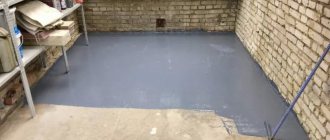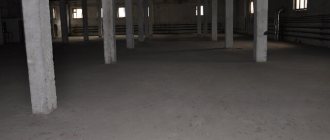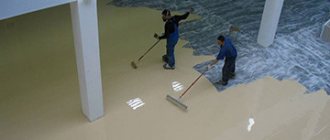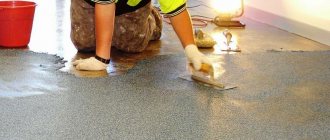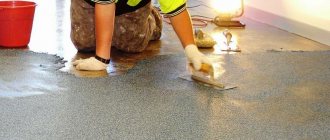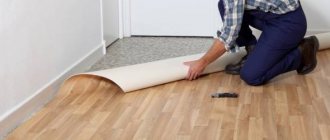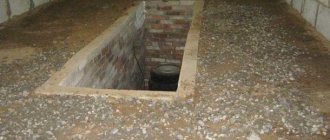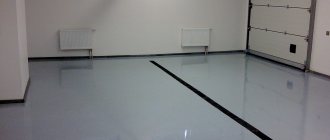Concrete floors are becoming an ideal solution not only in industrial settings; they are poured in a garage, workshop, basement, or on the ground floor of a private house. Due to the nature of the operation of concrete, a polymer coating for a concrete floor or other types of surface treatment becomes necessary. Let's figure out what materials are suitable for this task, what is the best way to cover the concrete base in order to extend its service life.
The absence of seams in the polymer floor facilitates the maintenance process Source design-homes.ru
Properties: why does a concrete base need protection?
The popularity of concrete floors in private construction is explained by the ease of making it yourself, using a minimal set of tools. The mixture includes a binder (cement), filler (gravel of various formations, sand, stone chips), improving additives and water, which makes the material affordable. The owners make a choice in favor of a concrete coating, taking into account other advantages of the material:
- Reliability, mechanical strength and long service life.
- Resistance to aggressive environments.
- Fire safety.
- Easy care.
However, the concrete surface begins to lose homogeneity over time, which is associated with two processes:
- Changes in temperature and humidity reduce the strength of the top layer, microcracks form on it, and then potholes appear.
- The porosity of the material, the release of salts to the surface, as well as its low tensile strength lead to the fact that under load the top layer begins to peel off. That's why the concrete floor gets dusty.
The garage floor is subjected to serious stress Source pinimg.com
The appearance of dust is a ubiquitous phenomenon, but most often it becomes obvious to the owner only after the floor has begun to be used. This situation is unacceptable not only for production, but also for a home garage or workshop.
To get rid of dust, special coatings for concrete floors are used. It is best to prevent the problem at the construction stage: after the concrete mixture has hardened, treat the surface with paint or another composition. As a result of the treatment, the pores on the surface will be clogged, and the wear resistance of the coating will improve.
In practice, several methods are used to protect concrete surfaces using different materials and technologies. Their diversity is enough to choose the most appropriate and effective option for specific conditions.
Component composition
Materials for polymer floors can be one-, two- and three-component. The most common are two-component mixtures consisting of a base material (B) and a hardener (P).
The components of the base include polymer resin, various pigments, and microfillers. Also, in addition to the base and hardener, manufacturers may include additional additives in the mixture. Most often this is done to improve the characteristics of the coating or to increase the shelf life of the mixtures.
Important! If you intend to fill it yourself, use one-component formulations. They are quite convenient to use, since during the dilution of the compound the possibility of making a mistake is eliminated. However, after opening the package, you need to use the mixture very quickly, otherwise it will dry out.
Three-component materials are used only by professionals, because they are quite difficult to work with. If the proportions are not observed, the surface will begin to crack after a while and the floor will have to be replaced.
Topping systems
Topping is a dry mixture used to harden the surface of a concrete floor (another name is hardening mixture). The technology has the following features:
- The mixture is applied to fresh concrete (immediately after laying). It is distributed over the surface; for large areas, a distribution machine is used.
Grouting industrial concrete floors Source mpkm.org
- Topping consumption depends on the expected load. If the load is small or medium, use approximately 3 kg/m². For medium or heavy loads, the flow rate is increased to 4-5 kg/m².
- The mixture absorbs moisture from the concrete mixture and darkens, after which it is pressed in with a trowel. The topping becomes one with the concrete base.
The basis (binder) of the topping, like concrete, is cement. Fillers are responsible for the functional properties: quartz, corundum (mineral or synthetic), iron carbide, and other compounds. Chemical plasticizer additives control the filling and shrinkage process. Thanks to coloring pigments, the topping can obtain any shade and texture (smooth or grainy), so it is convenient to use as a topcoat.
The use of topping systems has a beneficial effect on surface characteristics as follows:
- Increases impact resistance and wear resistance. The service life of the surface increases several times, the risk of cracks and chips is significantly reduced.
Polished concrete screed in a garage Source nikastroy.ru
- Stops dust formation. The surface layer acquires a dense structure, becomes even and smooth. This facilitates dry and wet cleaning, which is useful from the point of view of hygiene and health.
- Light-colored toppings reflect light well, which allows you to save on lighting costs.
The use of toppings as a coating for concrete has the following limitations:
- It is more profitable to use dry mixtures in large areas (in workshops, warehouses, parking lots), where heavy equipment operates.
- They are not suitable for areas where chemicals are used (and spilled).
- In rooms with high humidity, sealing impregnations are additionally used.
Primers, impregnations, primers
Primer (primer) is a material that is used for preliminary preparation of the surface (if you are then going to apply the finishing coat). Primers are often (and erroneously) called impregnations, which, in fact, are independent impregnating sealing materials.
All these materials are not external, but penetrating; their main advantage is that they help to quickly and efficiently remove dust from the floor in the garage.
Concrete surface needs dust removal Source ad-cd.net
See also: Catalog of companies that specialize in finishing materials and related work
The basis of primers and impregnations are film-forming substances (polymers). The compositions may be natural or synthetic. After application, they penetrate into the pores of concrete and strengthen the loose structure, binding it with polymer molecules.
As a result, concrete practically stops dusting and becomes stronger. It better withstands negative temperatures and exposure to accidentally spilled acids and alkalis. To strengthen the concrete coating, the following types of impregnating materials are used:
- Polyurethane. Suitable for both primer and finishing layers, improve waterproofing and protect against abrasion. The floor is treated twice, undiluted. The best polymerization result is obtained at moderate temperatures (0-17°C) and humidity not lower than 70%. Polyurethane primer is often used to repair surfaces, for which it is mixed with sand.
- Water-dispersed. A budget option, made on a water basis, there is practically no smell. The main property is dust removal, the surface is slightly strengthened. Before application, water-dispersion mixtures are diluted with water.
Applying primer mixture Source opscool.ru
- Epoxy. The main property of epoxy primers is waterproofing. Like any epoxy resin-based materials, these are two-component formulations that must be mixed immediately before application and used at temperatures from +5°C.
Care instructions
In order for a self-leveling floor covering to retain its luster for as long as possible, it requires proper care. It is similar to parquet maintenance. The method of maintaining the excellent condition of the floor is wet or dry type of cleaning, and with the first option, you can use special products for polymer floor surfaces, which are based on special acids. In case of heavy contamination, it is important to leave the composition on the surface for 5 minutes. Afterwards, you need to thoroughly rinse off the product with clean water. In industrial premises, it is preferable to use special units with powerful pressure for floor cleaning, which remove deep dirt from the surface. In no case should you leave toxic substances on the floor surface, as there is a risk of damage to the structure of the polymers. Periodically, you can treat the floor surface with a special paint and varnish material to update the appearance.
Paints for concrete
Paints of various compositions are widely used among concrete floor coatings. Since they are classified as finishing coatings, the surface is prepared before application: cleaned and primed. This increases the service life of the coating; it is only important to choose a primer based on the same polymer as the dye.
Epoxy paint
Epoxy paint forms the hardest and therefore wear-resistant coating for a concrete base, which can be used both indoors and outdoors. Epoxy resin paint can be used on freshly laid concrete; This feature reduces construction time.
A floor coated with epoxy paint has the following advantages:
- High waterproofing and no dust.
- Resistance to chemically active substances (solvents, oils, gasoline, acids and alkalis).
Epoxy paint for concrete Source beton-house.com
- Simplified care. The paint fills the pores in the loose outer layer of concrete, the dirt remains on the surface and is easy to remove.
- Increased wear resistance, aesthetic appearance. The paint does not wear off over time, does not turn yellow under the influence of ultraviolet radiation, and is convenient to use for marking.
Acrylic
Acrylic paints are mostly water-based, although there are more durable solvent-based options. The basis of the composite composition is polymer and acrylic resins, which form a durable, elastic and moisture-resistant polymer film.
To obtain the best result, the paint is applied to a dry floor, previously strengthened with acrylic primer (drying time up to 6 hours). It is applied in two steps, with a drying interval of 2 hours. Concrete coated with acrylic paint has the following advantages:
- Quick results. Less than a day passes from applying the primer to the start of operation.
- The base does not require leveling or perfect preparation.
- When dry, the acrylic layer acquires a dense matte texture, which visually evens out the base.
Acrylic paint for concrete floors Source beton-house.com
- The paint is affordable, and there are matte and glossy varieties on sale.
- Acrylic paint is easy to work with: applied with a brush, roller or spray, depending on the scale of the work.
Polymer coating technology:
- Preparing the concrete base.
- Padding.
- Applying the base layer.
- Installation of decorative elements.
- Sealing with surface varnish (finishing layer).
Possible decorative solutions for polymer floors.
- Color solutions. Choice of color or combination of colors, chaotic mixing of colors under the roller.
- Filling the uncured layer with decorative flocks (“chips”) of various natures - pieces of acrylic paint of various colors, metallized, fluorescent, small glitter, etc.
- Gluing a photo image or drawing in a three-dimensional design, the so-called 3d self-leveling floors.
- Drawing made by the artist.
- Using colored sand to create a so-called “stone carpet”. Here you can also choose the color of the sand, the configuration of the pattern, the size of the sand particles, the degree of surface sealing with varnish, from a structured surface to a smooth one.
- Embedded elements - coins, pebbles, dried leaves, flowers, coffee beans, etc., creating panels on the floor.
- Creating the effect of depth and volume using Venetian plaster techniques.
Using various techniques, you can get a voluminous, multi-dimensional pattern on the floors. The decorative solution of the floor is directly dependent on the design solution of the overall interior. We must also not forget about the purpose of the room; a person should feel comfortable and convenient at home. In our practice, there was a case when the owners of an apartment wanted to make bright red purple roses in the kitchen, and the design was repeated many times. The result was such ripples that it was impossible to stay in this room for a long time. I had to redo the floors, time and money were wasted. You also need to be thoughtful about photo floors. The subject of the image should not shock or frighten. The choice of images must be taken very seriously.
Polyurethane
One way to protect the concrete surface and at the same time give it an attractive appearance is to use polyurethane dyes. Before applying polyurethane paint, the floor is prepared: dried, cleaned of dust, and oil (grease) stains are removed. Coloring is carried out in two stages, the second layer - no earlier than a day after the first.
The peculiarity of polyurethane-based paints is that they need from 2 to 14 days to dry completely. At the same time, the dye reaches a dry, tack-free state within a couple of days, after which small mechanical loads are acceptable.
During the remaining time, the polyurethane coating on the concrete floor continues to gain mechanical and chemical resistance. Using paint provides the following advantages:
- The dye is used for interior and exterior work and is highly resistant to weather vagaries.
Polyurethane two-component paint for industrial floors Source prom.st
Advantages and disadvantages
Original crackle effect - cracks
The polymer floor has no seams.
The main advantage of the self-leveling polymer floor is its attractive appearance, due to the absence of seams on the coating. The polymer material gives the floor a shine, which, being a distinctive feature, gives the room an aesthetic appearance.
In addition, the advantages of polymer flooring include wear resistance, moisture resistance and durability. Based on sealed materials, such a floor closes all, even the smallest, holes and cracks, preventing moisture and chemicals from penetrating into them.
Manufacturers of materials for the installation of self-leveling polymer floors claim that the service life of such coatings, made in compliance with the technology, is at least 40 years.
Glossy shine maintains the image of luxury.
The polymer floor does not lose its qualities even in the temperature range from -60 to 90°C. At high temperatures, these floors do not ignite, do not smoke or emit harmful toxic substances.
The positive qualities of polymer floors include their good adhesion to all possible types of bases and the absence of gaps. Installing a floor does not take much time or effort. You just need to pour the mixture and wait for it to dry.
One of the disadvantages of polymer floors is the lack of different color options. You can only choose between gray and brown tones. Another disadvantage is the impossibility of replacing such a floor, since such a covering cannot be dismantled. You can only cover it with another layer on top, for example, cover it with carpet, parquet or another type of covering.
Alternative coatings for concrete
You can protect concrete from destruction, and yourself from dust, without resorting to impregnations and paints. Alternative coatings for concrete can provide an aesthetic appearance to the floor and provide practical protection even in difficult garage conditions. The following materials can effectively protect a concrete base:
- Ceramic tile. Durable, easy to clean and abrasion resistant material. The best quality solution for a garage would be clinker tiles; The floor can also be covered with porcelain stoneware. A practical solution would be an unglazed or embossed material with a high level of abrasion (class five). Regular ceramic tiles will not withstand garage conditions.
Porcelain tiles for garage floor cladding Source design-homes.ru
- Rubber tile. Modular tiles made from rubber crumbs are suitable for garages, car washes or auto repair shops. It is resistant to salt solutions, motor oils and alkalis, and does not slip when wet. A fallen part or tool will not damage the coating and will remain intact. Important advantages of the modules are wear resistance, ease of cleaning and a wide color palette.
- PVC tiles. In the garage, a lot of time is spent on cleaning, especially with the arrival of winter with its slush and salt stains. PVC tiles will simplify the problem; This is an unpretentious coating, more durable than paint and less expensive than tile. Its assembly does not require cementation, and it does not slip during operation. If one element gets damaged, it is replaced without disturbing the structure.
Modular rubber tile floor Source pinimg.com
- Rolled rubber for the garage (also mats). A variety of products made from rubber and rubber crumbs; used in garages, fitness rooms, on treadmills. Main advantages: quick installation, no slipping, low abrasion, long service life (up to 20 years), varied appearance.
Self-leveling floors
This is the name of a special type of screed, for the production of which self-leveling mixtures are used. The main feature of the technology is the ability to create a coating of minimal thickness (up to 3.5 mm). Based on their use, self-leveling floors are divided into finishing and screeds; based on material, they are divided into mineral and polymer compositions, which differ in the pouring process.
A significant advantage of the technology (as opposed to cement screed) is its low labor intensity and high productivity. If the technology is followed, the mixture automatically levels itself to a horizontal plane. As a result, you get a durable and wear-resistant coating for concrete floors, the only disadvantage of which is its high cost.
Distribution of the mixture over the surface Source aviarydecor.com
Preparing the mixture
To fill a polymer floor, you need to prepare a solution. This is one of the most critical operations, the correct execution of which determines the quality of the entire coating. For more information about pouring polymer onto the floor, watch this video:
The solution must be prepared strictly according to the attached instructions. Particular attention must be paid to stirring the mixture so that no lumps remain and air bubbles do not form.
It is more advisable to mix using a mixer or a special attachment on a drill.
Video description
About the benefits of impregnation for concrete in the following video:
The basis of mineral self-leveling floors is a cement mixture; additives are fillers that determine performance characteristics. There are three types of mineral mixtures on the market:
- Basic. It is used for initial alignment (adjustment is needed afterwards). Scope of application: concrete foundations with a slope of up to 80 mm.
- Average. Foundations whose slope does not exceed 30 mm.
- Finish. Performs final leveling for subsequent flooring installation.
Polymer self-leveling floors are needed where increased demands are placed on the surface in terms of reliability, abrasion resistance, and resistance to chemical influences. Polymer coatings for concrete are classified according to the thickness of the material or the composition of the mixture. Based on the binding component, the following types are distinguished:
- Epoxy polymer self-leveling floor. It is particularly durable and inert to chemically aggressive environments. Sold as a two-component mixture including working resin and thickener. The best option for indoor spaces with high loads (garage, warehouse, workshop, shopping center).
Self-leveling self-leveling floor Source twimg.com
- Polyurethane. Its peculiarity lies in its higher shock-absorbing properties. In practice, such a base will be more resistant to tension and impact loads. The application technology is more complex than for the epoxy analogue and requires more experience.
- Methyl methacrylate. Methyl methacrylate flooring hardens very quickly; use can begin within 2-3 hours, including outdoors, and even in frosty conditions. The disadvantage of the material is its price; It is also extremely difficult to apply without skill, especially over a large area. After hardening, the floor is harmless, but during the application stage it is necessary to ensure good ventilation and protect the respiratory tract (true for some brands).
Self-leveling floors in loft style (with topping) Source mpm-pol.ru
Areas of application of polymer floors
- Warehouse terminals - warehouses, hangars, vegetable warehouses, granaries, etc.
- Automotive complexes - parking lots, garages, car services, car washes, car maintenance centers, etc.
- Food and agricultural industries - dairies, poultry farms, cowsheds, fur farms, distilleries, meat and fish processing shops, canned food production, flour mills, sugar factories, bakeries, etc.
- Chemical and pharmaceutical production - polymer production, petrochemical complexes, production of medical equipment and medications, laboratories, production of household chemicals, cosmetics, etc.
- Mechanical engineering - automobile and engine factories, foundries and steel rolling plants, metalworking industries, etc.
- Trade industry - exhibition complexes and halls, markets, pavilions, shopping and entertainment centers, office premises, supermarkets, hotels, etc.
- Sports facilities - tennis courts, water parks, sports complexes with adjacent territories, sports grounds, etc.
- Other industry - woodworking, pulp and paper mills, carpentry and metalwork shops, instrument-making factories, energy industry, electronics production, etc.
- Polymer floors have become popular for arranging flooring in residential premises and even apartments.
Briefly about the main thing
Concrete pouring is an ideal option for organizing the floor in a garage, basement, workshop or other utility rooms. But such a coating requires additional protection, since during operation the concrete wears out and forms dust. To extend the service life of concrete, various methods are used to protect its surface.
The compositions used include topping systems, primers (primers), impregnations and paints. Depending on the composition, acrylic, epoxy and polyurethane materials are distinguished. A separate type of coating consists of self-leveling floors, as well as floor materials: ceramic, rubber and PVC tiles.
Preparatory work
The surface for pouring the polymer must be perfectly flat and clean.
One of the main requirements for surfaces intended for the installation of self-leveling floors is their evenness. For a base made of boards, it is necessary to carry out work to seal irregularities and cracks between the wooden elements.
When pouring floors over tiles, on the contrary, it is necessary to create surface roughness for reliable adhesion. The surface can be leveled using a concrete or mortar screed, as well as a primer. For more information on preparing the floor for finishing, watch this video:
To prevent the polymer mixture from spreading into the spaces between the floor and walls, it is advisable to construct a contour of wooden slats around the perimeter.

